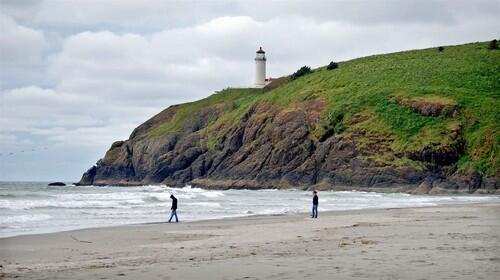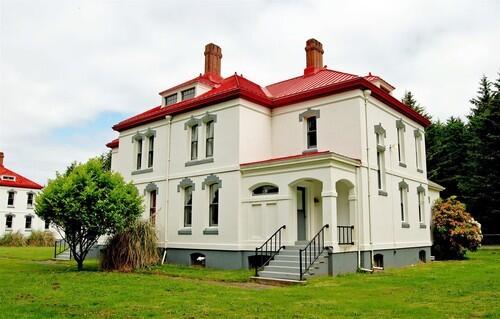Cape Disappointment State Park in southern Washington

Graveyard of the Pacific
Cape Disappointment is on the southern tip of the Long Beach Peninsula in southern Washington. The area around the cape is known as the “Graveyard of the Pacific” for its treacherous waters, rocky cliffs and ever-changing sandbar formed by the Columbia River. North Head Lighthouse, first lighted in 1898, was the second of two lighthouses built on the cape. (Tim Hubbard / Los Angeles Times)

North Head Lighthouse
Visitors check out the view from the North Head Lighthouse at Cape Disappointment State Park. The 65-foot-tall lighthouse was first illuminated in 1898. The original lens burned five gallons of kerosene a night and could be seen 20 miles out to sea. In 1998, a marine rotating beacon was installed. North Head was the second of two lighthouses built on Cape Disappointment. (Tim Hubbard / Los Angeles Times)

Lewis and Clark Interpretive Center
The Lewis and Clark Interpretive Center can be seen across Dead Man’s Cove from Cape Disappointment Lighthouse. A muralized timeline chronicles Lewis and Clark’s westward journey to the Pacific Ocean. Sketches, paintings and writings help depict the trials and triumphs of their three-year odyssey. There’s a gift shop loaded with Lewis and Clark memorabilia, as well as books and posters pertaining to the uniqueness of the maritime locale. (Tim Hubbard / Los Angeles Times)

William Clark and Corps of Discovery
This bronze marker commemorates the location of
Advertisement

Dead Man’s Cove
A look down at Dead Man’s Cove, which can be seen during the 1.2-mile round-trip hike to Cape Disappointment Lighthouse. The cove can be accessed through stairs from the Lewis and Clark Interpretive Center. As the story goes, the body of a shipwreck victim washed up on the shore here thus the cove’s name. (Tim Hubbard / Los Angeles Times)

Cape Disappointment Lighthouse
This was the first of two lighthouses constructed at Cape Disappointment. Ironically, the cargo ship carrying the materials to construct the lighthouse wrecked directly below the cape in 1853. The 53-foot-tall lighthouse was first illuminated in 1856. The horizontal black stripe was added later to distinguish it from North Head Lighthouse, which became operational in 1898. (Tim Hubbard / Los Angeles Times)

Astoria Column
This 125-foot column sits atop Coxcomb Hill in Astoria, Ore., southeast of Cape Disappointment across the Columbia River. (Tim Hubbard / Los Angeles Times)

Etchings on the column depict vignettes of the areas past. Interior stairs, which are currently being replaced, lead to an observation deck and views of the Columbia River. (Tim Hubbard / Los Angeles Times)
Advertisement

Astoria-Megler Bridge
Take a spin across the 3-mile-long bridge that leads to the fur-trading enclave founded by John Jacob Astor in 1810. (Tim Hubbard / Los Angeles Times)

Wet Dog Cafe & Astoria Brewing Co. in Astoria
Many would say this place has all the ingredients for a great dining experience: good food, enjoyable atmosphere, reasonable prices and tasty microbrewery beer. (Tim Hubbard / Los Angeles Times)

Wet Dog Cafe &
One recommended combination is the chicken wings with a pint of Shark Spit IPA. (Tim Hubbard / Los Angeles Times)

Rental House
Back at Cape Disappointment, the former residence of the head lighthouse keeper at North Head can be rented for $377 plus tax per night. Two adjacent houses rent for $267 plus tax per night but lack the view offered by this main house. The refurbished house accommodates six guests. Hardwood floors extend from the living room into the lovely grand dining room and library. The century-old, two-story Victorian-period house features a comfortable living room with TV and DVD player, a spacious tiled kitchen with modern appliances, and three bedrooms with two queen-size and two single beds. (Tim Hubbard / Los Angeles Times)



